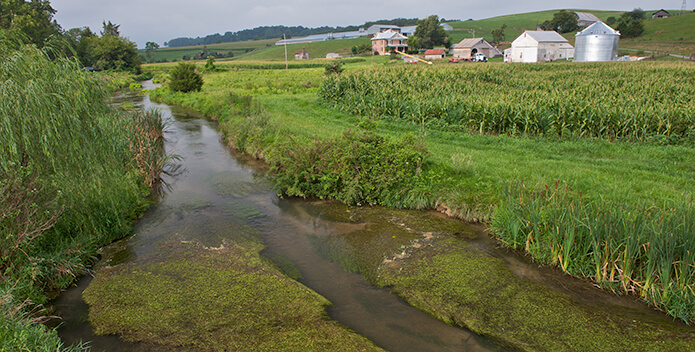Agriculture covers the largest land area of any industry in Virginia. Not surprisingly, it is also the largest source of nutrient and sediment pollution reaching local streams and the Chesapeake Bay. Even though many well-operated farms employ sound conservation practices that protect water quality, many more farmers would like to put these practices in place but need technical and financial support.
That's where Virginia's Agricultural Cost-Share Program comes into play. Established in 1984, this program has helped thousands of farmers implement conservation practices that prevent pollution from reaching waterways. These "best management practices" or BMPs include fencing livestock out of streams, planting buffers of trees and native plants along waterways, nutrient management plans that ensure farmers use the right amount of fertilizer, and many other practices essential to protecting our streams and the Bay. The program also provides technical support to help farmers properly install these projects in the best locations. When working with farmers, CBF field staff often recommend this program as a source of assistance.
For decades, Virginia's agricultural cost-share program has helped thousands of farmers adopt conservation practices by providing state funding for a significant portion of installation costs. But this successful program was seriously underfunded for years. Fortunately, in 2022 Virginia's General Assembly provided historic levels of funding to agricultural cost-share programs.
Farmers face numerous challenges to profitably produce food for our dinner plates. While most conservation practices also help improve the farm's bottom line in the long-run, they can be expensive initially. Many farms could not take on these game-changing conservation projects without financial support. Farmer interest in cost-share is typically greater than the available funds can support, leaving potential improvements to wait for future funding.
Investments in these practices lead to cleaner water, create jobs, and help the local economy. A network of small businesses—from contractors to lumber yards to tree nurseries—benefit when a farmer installs a one of these projects. Nutrient management plans allow farmers to maximize yield so they save on fertilizer costs while maintaining production. Studies have shown that implementing farm conservation practices at levels necessary to restore the Chesapeake Bay would create nearly 12,000 jobs and that every $1.00 invested in Bay restoration will generate $4.00.
How Virginia's Cost-Share Program Works
VACS is administered by the Virginia Soil and Water Conservation Board and the Virginia Department of Conservation and Recreation through 47 local soil and water conservation districts. The primary source of funding for VACS is the Water Quality Improvement Fund (WQIF) and the Virginia Natural Resources Commitment Fund (VNRCF), a sub-fund of WQIF created in 2008 to specifically support agricultural best management practices.
Each soil and water conservation district is allocated a set amount of cost-share funding each year, based on the amount of funds available statewide, as well as the potential to improve water quality in their local streams. Projects are prioritized on a district by district basis, with decisions on project approval made by the local soil and water conservation board. The boards are made up of locally elected community members.
Cost-share payments vary by practice, from 50 percent up to the full cost of implementation, and there is a maximum payment of $300,000 per year for an individual. To be eligible, projects must be on farms at least five acres in size that earn at least $1,000 annually, and projects must address an existing water quality problem.
VACS funding has historically fluctuated widely from year to year. However, in 2022 Virginia provided historic levels of investment in agricultural cost-share, for the first time ever fully funding the program over the next two years.
Why Agricultural Cost-Share is Important to Meeting Virginia's Blueprint Goals
Virginia reduced the amount of nitrogen pollution from its agriculture sector by 981,623 pounds between 2010 and 2021. To reach its Clean Water Blueprint goals by 2025, the Commonwealth is relying on farms to cut an additional 6.2 million pounds of nitrogen. That amount accounts for 74 percent of the remaining nitrogen reductions statewide.
VACS is a critical part of Virginia's plan to meet its pollution reduction goals by 2025. It helps farmers across the Commonwealth adopt sound, cost-effective conservation practices such as installing cover crops, as well as projects with long-term benefits, including fencing cattle out of streams and planting streamside trees and grasses. These are among the best steps Virginia can take to restore the Bay and local streams.
While there have been many positive improvements to the VACS program in the last several years, robust, reliable funding for best management practices is essential for meeting the water quality goals outlined in the Commonwealth's final Clean Water Blueprint. The plan estimates that more than $100 million will be needed for cost-share annually. The Blueprint also notes that, in order to accelerate the implementation of agricultural conservation practices, a higher percentage of cost-share funding should be directed to targeted portions of the Chesapeake Bay watershed.



